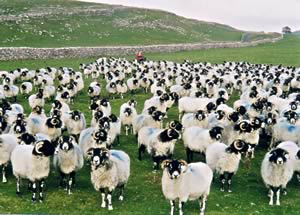 |
|||||||||
|
|||||||||||||||||||
Emphasis
on Health in Swaledale Flock With the entire female lamb crop selling through a handful of autumn sales, Ashley Caton places great emphasis on the health of his stock to ensure they thrive and to benefit future buyers.
He runs a flock of 800 Swaledale ewes at Otterburn Lodge, Otterburn, near Skipton – producing Mule gimmer lambs, which are all sold at North of England Mule Sheep Association Sales in North Yorkshire. As chairman of his NEMSA Skipton branch – his late father Val was President of the Association – Ashley is well aware that the health status of his gimmer lambs is an important consideration for buyers. The flock averages around 190 pc scanned lambs and both female and male lambs are scratched for orf. This keeps the viral disease, which causes significant welfare and economic problems, well under control. “It’s an insurance policy. Not only do the lambs thrive better, but buyers look at the sale catalogues for lambs that have been vaccinated against orf,” said Ashley Caton. “We sell 95% of our gimmer lambs in September at NEMSA sales at Skipton and Hawes. If you have a set-back you lose the short window of opportunity to sell your lambs. Scratching against orf also minimises the chances of the disease being transferred to humans.” Ashley Caton is the fourth generation of his family to farm Otterburn Lodge since 1919 and he admits that sheep are his passion. The farm is 800 acres, 530 of which are owner-occupied. It is two main blocks of land, one on lower lying heavy clay at Otterburn and the other on enclosed limestone pasture rising to 1,500ft above sea level at Malham. All replacements for the Swaledale flock are bought from known flocks as gimmer lambs at Middleton-in-Teesdale and Hawes. The farm’s 100 cow Holstein Friesian dairy herd went in 2003 to be replaced by 80 Limousin cross suckler cows run on a simple system, put back to the Limousin bull producing calves which go into the store market at 10-12 months old the following spring after calving outside. The farm also has a flock of 30 pedigree Bluefaced Leicesters to produce rams for use at Otterburn Lodge as well as rams and females for sale at Hawes and Skipton with rams selling to £2,200 in 2004 at Hawes. Such is the success of Mule gimmer lambs bred at Otterburn Lodge that every year since 2001 they have earned a first prize ticket at pre-sale shows, including two firsts in the pens of 10 and four firsts in the pens of 20. At the local Malham summer show the NEMSA rosette and award for the best single lamb have been won four times and in 2005 the Catons had the supreme champion sheep on the field - an unusual feat for a crossbred sheep. At tupping time in October the Swaledale ewes are brought down from the limestone pastures at Malham and flushed on the better grazing land at Otterburn. With flock health a high priority, the ewes are drenched for fluke and worms as well as given vitamins and trace elements. They are also vaccinated against footrot with Footvax, which has significantly reduced the incidence of footrot, saving time and money spent on antibiotics. The ewes are returned to the drier Limestone pasture which makes for easier feeding, initially with sugar beet pulp then an 18% protein concentrate, from mid December until the end of February when they are brought back to Otterburn for lambing. The Bluefaced Leicesters start lambing in early March with the hill ewes beginning at the end of March – beginning of April. The Bluefaced Leicester lambs are all scratched with the Scabivax Forte orf vaccine within a day and a half of birth, which is indoors. The Swaledales are lambed outside and both males and females are vaccinated in early May when they are marked and tailed. “We used to have a big problem with orf in the Bluefaced Leicesters on their udders and vaccinating has definitely improved this. We see very little orf in the Mule lambs – just maybe in a few late-born lambs, which have missed being scratched. It makes us feel the product is doing the job. “From a breeding sheep point of view I feel we can’t afford not to vaccinate against orf. If there was an outbreak among the Mule gimmer lambs they would become unsaleable, never mind that they wouldn’t thrive,” said Ashley Caton. While he cannot remember when the regular orf vaccination programme began at Otterburn Lodge, he was asked by his vet Neil Roberts, of the Dalehead Veterinary Group in Settle to try the latest orf vaccine when it first came on the market two years ago. “The new Scabivax orf vaccine with its improved applicator is much easier to use. The applicator delivers the same dose each time, which means lambs are getting the required amount of the vaccine. It is also quicker to use. “The new pump mechanism applicator can also be put down without spillage. This and the greater accuracy also make it more cost-effective.” Mule wether lambs are also scratched to ensure that they thrive – they are all finished off grass weighing more than 40 kg from August to early December. “I like to finish the lambs off grass because it’s the most efficient way. Also, I want wether lambs off the farm by early December so they are not eating keep that the breeding sheep should have,” added Ashley Caton.
|
|||||||||||||||||||

|
|
||||||||||||||||||
| home | agri-services | pedigree
pen | news | dairy | beef | machinery property | organisations | site map |
|||||||||||||||||||

Article by
Jennifer MacKenzie
